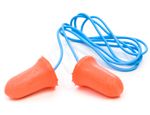We frequently get calls to come and assess noise levels in industrial facilities. The concern is usually whether the employee’s exposure to noise is meeting OSHA requirements. So what are standard OSHA requirements for employee noise exposure?
There are three main points to the OSHA noise exposure requirements. The exposure limit is based on a time-weighted average (TWA) of 90 dBA over an 8-hour period. That means a person can be exposed to different noise levels over the 8-hour work shift, but the average noise level is the determining factor. The second part to the OSHA requirement is that only noise levels above 80 dBA are included in the TWA. So if a person works in one area with noise levels at 78 dBA and then moves into a louder production area with noise levels at 90 dBA, only the time spent in the louder production area are included in the time-weighted average. The last piece of the requirement is that hearing protectors must be available to all workers exposed to 8-hour TWA noise levels of 85 dBA or above.
The key to all of this is proper noise monitoring. Employees who work in noisy environments can get accustomed to the noise level and may not be aware of increases in level that could cause permanent damage. If the noise levels in a facility are periodically monitored, any changes in noise level can be addressed to maintain OSHA compliance. Many times the noise can be addressed at the source, minimizing the need for hearing protection.
At Acoustics By Design, we perform dosimetry tests and employee noise exposure monitoring for companies that want to ensure they meet the OSHA requirements. As professional engineers, we can develop mitigation options that go beyond the quick fix of earplugs.
